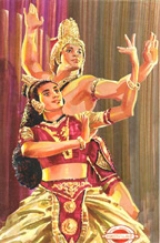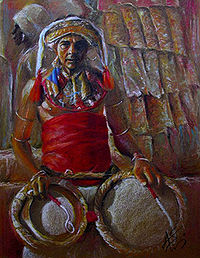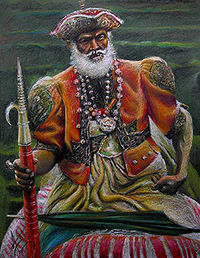
Kandyan Dance
Encyclopedia
Kandyan Dance is a dance form that originated in the area called Kandy
of the Central hills region in Sri Lanka
. But today it has been widespread to other parts of the country.
 According to the legend, the origins of the dance lie in an exorcism ritual known as the Kohomba Kankariya, which was originally performed by Indian shamans who came to the island.
According to the legend, the origins of the dance lie in an exorcism ritual known as the Kohomba Kankariya, which was originally performed by Indian shamans who came to the island.
According to legend, the Indian shamans came to the island upon the request of a king who was suffering from a mysterious illness. The king was said to be suffering from recurring dream in which a leopard directing its longue towards the king. Which is believed as a black magic of "Kuweni" the first wife of the king "Vijaya". After the performance of the Kohomba Kankariya the illness vanished, and many natives adopted the dance.
It was originally performed by dancers who were identified as a separate caste under the Kandyan Fudel system. They were aligned to the Temple of the Tooth
and had a significant role to play in the Dalada Perahera (procession) held each year by the temple.
The dance waned in popularity as the support for the dancers from the Kandyan kings ended during the British period. It has now been revived and adapted for the stage, and is Sri Lanka's primary cultural export.
Only toward the end of the nineteenth century were ves dancers first invited to perform outside the precincts of the Kankariya Temple at the annual Kandy Perahera festival. Today the elaborately costumed ves dancer epitomizes Kandyan dance.
The word "vannam" comes from the Sinhala word "varnana" (descriptive praise). Ancient Sinhala texts refer to a considerable number of "vannams" that were only sung; later they were adapted to solo dances, each expressing a dominant idea. History reveals that the Kandyan king Sri Weeraparakrama Narendrasinghe gave considerable encouragement to dance and music. In this Kavikara Maduwa (a decorated dance arena) there were song and poetry contests.
It is said that the kavi (poetry sung to music) for the eighteen principal vannams were composed by an old sage named Ganithalankara, with the help of a Buddhist priest from the Kandy temple. The vannams were inspired by nature, history, legend, folk religion
, folk art, and sacred lore, and each is composed and iterpreted in a certain mood (rasaya) or expression of sentiment. The eighteen classical vannams are gajaga ("elephant"), thuranga ("hourse") , mayura ("peacock"), gahaka ("conch shell"), uranga ("crawling animals"), mussaladi ("hare"), ukkussa ("eagle"), vyrodi ("precious stone"), hanuma ("monkey"), savula ("cock"), sinharaja ("lion"), naaga ("cobra"), kirala ("red-wattled lapwing"), eeradi ("arrow"), Surapathi (in praise of the goddess Surapathi), Ganapathi (in praise of the god Ganapathi), uduhara (expressing the pomp and majesty of the king), and assadhrusa (extolling the merit of Buddha). To these were added samanala ("Butterfly"),bo (the sacred bo tree at Anuradhapura, a sapling of the original bo tree under which Buddha attained enlightenment), and hansa vannama ("swan"). The vannama dance tradition has seven components.
The headgear in the ves costume can only be worn by the males & can only be worn after a special ceremony called ves mangalaya in which the male dancer first wears the ves vostume
and dances. Legend also says that if a female wears the headgear she will have a lot of bad luck or get very sick even the males if they have not performed at the ves mangalaya the same will happen to them(only males perform at the ves mangalaya and the females have a separate ceremony called Kalaveny mangalya).
 The Kandyan Dance is traditionally performed to percussion only. The most common drum is the Geta Beraya, which is only used in Kandyan Dance. To assist the dancer to keep rhythm a small pair of cymbals known as the Thalampota is also used. The Vannam's however have lyrics that are sung in tune with the movements of the dancer. These lyrics sing about the virtues of the animal that the Vanna is depicting.
The Kandyan Dance is traditionally performed to percussion only. The most common drum is the Geta Beraya, which is only used in Kandyan Dance. To assist the dancer to keep rhythm a small pair of cymbals known as the Thalampota is also used. The Vannam's however have lyrics that are sung in tune with the movements of the dancer. These lyrics sing about the virtues of the animal that the Vanna is depicting.
Another form of twin Drums called Tammettamahttp://www.britishcouncil.lk/kidsintouch/kandy/perahara.htm used with cane drum sticks.
 Even though originally only males were allowed train as dancers, there are now several schools which also train women in the Kandyan dance form. However there is no definite Ves costume for women, and many female dancers have adapted the male costume in different ways.
Even though originally only males were allowed train as dancers, there are now several schools which also train women in the Kandyan dance form. However there is no definite Ves costume for women, and many female dancers have adapted the male costume in different ways.
There are only a few performances of the Kohomba Kankariya now due to many social, economic and political reasons. The dance in its traditional form is still performed each year at the Dalada Perhahera in Kandy.
The Kandyan Dance was adapted for the stage by Chitrasena Dias in the 1970s, in several Ballets he choreographed, he has used kandyan dance movements and features. In some ways his popularity also helped to reduce the caste barriers surrounding the dance, and made it more palatable to an urban, contemporary audience. To date one of the largest school for Kandyan dance is Chitrasena Dance School.
Many contemporary dancers in Sri Lanka have borrowed from the Kandyan form for their work.
Kandy
Kandy is a city in the center of Sri Lanka. It was the last capital of the ancient kings' era of Sri Lanka. The city lies in the midst of hills in the Kandy plateau, which crosses an area of tropical plantations, mainly tea. Kandy is one of the most scenic cities in Sri Lanka; it is both an...
of the Central hills region in Sri Lanka
Sri Lanka
Sri Lanka, officially the Democratic Socialist Republic of Sri Lanka is a country off the southern coast of the Indian subcontinent. Known until 1972 as Ceylon , Sri Lanka is an island surrounded by the Indian Ocean, the Gulf of Mannar and the Palk Strait, and lies in the vicinity of India and the...
. But today it has been widespread to other parts of the country.
History

According to legend, the Indian shamans came to the island upon the request of a king who was suffering from a mysterious illness. The king was said to be suffering from recurring dream in which a leopard directing its longue towards the king. Which is believed as a black magic of "Kuweni" the first wife of the king "Vijaya". After the performance of the Kohomba Kankariya the illness vanished, and many natives adopted the dance.
It was originally performed by dancers who were identified as a separate caste under the Kandyan Fudel system. They were aligned to the Temple of the Tooth
Temple of the Tooth
Sri Dalada Maligawa or The Temple of the Sacred Tooth Relic is a Buddhist temple in the city of Kandy, Sri Lanka. It is located in the royal palace complex which houses the Relic of the tooth of Buddha. Since ancient times, the relic has played an important role in local politics because it is...
and had a significant role to play in the Dalada Perahera (procession) held each year by the temple.
The dance waned in popularity as the support for the dancers from the Kandyan kings ended during the British period. It has now been revived and adapted for the stage, and is Sri Lanka's primary cultural export.
Ves dance
"Ves" dance, the most popular, originated from an ancient purification ritual, the Kohomba Yakuma or Kohomba Kankariya. The dance was propitiatory, never secular, and performed only by males. The elaborate ves costume, particularly the headgear, is considered sacred and is believed to belong to the deity Kohomba.Only toward the end of the nineteenth century were ves dancers first invited to perform outside the precincts of the Kankariya Temple at the annual Kandy Perahera festival. Today the elaborately costumed ves dancer epitomizes Kandyan dance.
Naiyandi dance
Dancers in Naiyandi costume perform during the initial preparations of the Kohomba Kankariya festival, during the lighting of the lamps and the preparation of foods for the demons. The dancer wears a white cloth and white rurban, beadwork decorations on his chest, a waistband, rows of beads around his neck, silver chains, brass shoulder plates, anklets, and jingles. This is a graceful dance, also performed in Maha Visnu (Vishnu) and Kataragama Devales temples on ceremonial occasions.Uddekki dance
Uddekki is a very prestigious dance. Its name comes from the Uddekki, a small lacquered hand drum in the shape of an hourglass, about seven and half inches (18 centimeters) high, believed to have been given to people by the gods. The two drumskins are believed to have been given by the god Iswara, and the sound by Visnu; the instrument is said to have been constructed according to the instructions of Sakra and was played in the heavenly palace of the gods. It is a very difficult instruments to play. The dancer sings as he plays, tightening the strings to obtain variations of pitch.Pantheru dance
The pantheruwa is an instrument dedicated to the goddess Pattini. It resembles a tambourine (without the skin) and has small cymbals attached at intervals around its circumference. The dance is said to have originated in the days of Prince Siddhartha, who became Buddha. The gods were believed to use this instrument to celebrate victories in war, and Sinhala kings employed pantheru dancers to celebrate victories in the battlefield. The costume is similar to that of the uddekki dancer, but the pantheru dancer wears no beaded jacket and substitutes a silk handkerchief at the waist for the elaborate frills of the uddekki dancer.Vannams
Originally Vannams were kind of recitations. In most Vannams it describes about the behaviours of animals like Elephants, monkeys, rabbits, peacock, cocks, serpents etc. Later dancers have used Vannam as background songs for their performances. There are 18 Vannams in the Kandyan Dance form. Traditionally a dancer would have to learn to perform all these Vannams before they would be gifted the Ves costume. The most well known among these are the Hanuma Vannama (Monkey), The Ukusa Vannama (Eagle) and the Gajaga Vannama (Elephant).The word "vannam" comes from the Sinhala word "varnana" (descriptive praise). Ancient Sinhala texts refer to a considerable number of "vannams" that were only sung; later they were adapted to solo dances, each expressing a dominant idea. History reveals that the Kandyan king Sri Weeraparakrama Narendrasinghe gave considerable encouragement to dance and music. In this Kavikara Maduwa (a decorated dance arena) there were song and poetry contests.
It is said that the kavi (poetry sung to music) for the eighteen principal vannams were composed by an old sage named Ganithalankara, with the help of a Buddhist priest from the Kandy temple. The vannams were inspired by nature, history, legend, folk religion
Folk religion
Folk religion consists of ethnic or regional religious customs under the umbrella of an organized religion, but outside of official doctrine and practices...
, folk art, and sacred lore, and each is composed and iterpreted in a certain mood (rasaya) or expression of sentiment. The eighteen classical vannams are gajaga ("elephant"), thuranga ("hourse") , mayura ("peacock"), gahaka ("conch shell"), uranga ("crawling animals"), mussaladi ("hare"), ukkussa ("eagle"), vyrodi ("precious stone"), hanuma ("monkey"), savula ("cock"), sinharaja ("lion"), naaga ("cobra"), kirala ("red-wattled lapwing"), eeradi ("arrow"), Surapathi (in praise of the goddess Surapathi), Ganapathi (in praise of the god Ganapathi), uduhara (expressing the pomp and majesty of the king), and assadhrusa (extolling the merit of Buddha). To these were added samanala ("Butterfly"),bo (the sacred bo tree at Anuradhapura, a sapling of the original bo tree under which Buddha attained enlightenment), and hansa vannama ("swan"). The vannama dance tradition has seven components.
Costume
The dancers wear an elaborate costume including a headdress. The dancer's chest is only covered by a decorative beaded net. This costume is known as the Ves costume. The headdress incorporates a metallic front which makes the dancer look taller than he is. The complete costume also includes anklets that produce a metallic rattle eachThe headgear in the ves costume can only be worn by the males & can only be worn after a special ceremony called ves mangalaya in which the male dancer first wears the ves vostume
and dances. Legend also says that if a female wears the headgear she will have a lot of bad luck or get very sick even the males if they have not performed at the ves mangalaya the same will happen to them(only males perform at the ves mangalaya and the females have a separate ceremony called Kalaveny mangalya).
Music

Another form of twin Drums called Tammettamahttp://www.britishcouncil.lk/kidsintouch/kandy/perahara.htm used with cane drum sticks.
Kandyan dance today

There are only a few performances of the Kohomba Kankariya now due to many social, economic and political reasons. The dance in its traditional form is still performed each year at the Dalada Perhahera in Kandy.
The Kandyan Dance was adapted for the stage by Chitrasena Dias in the 1970s, in several Ballets he choreographed, he has used kandyan dance movements and features. In some ways his popularity also helped to reduce the caste barriers surrounding the dance, and made it more palatable to an urban, contemporary audience. To date one of the largest school for Kandyan dance is Chitrasena Dance School.
Many contemporary dancers in Sri Lanka have borrowed from the Kandyan form for their work.

